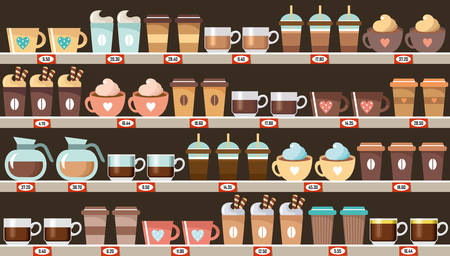Historical Context of Coffee Breaks in the UK
The tradition of taking a break during the workday is deeply rooted in British culture, though it has not always revolved around coffee. Historically, tea has been the beverage of choice for most Britons, with the classic “tea break” becoming an established part of workplace routine during the industrial revolution. Factories and offices would often schedule short pauses mid-morning or mid-afternoon, allowing workers to recharge and socialise over a hot cup of tea. Over time, as global trade expanded and coffee became more widely available, coffee began to find its place alongside tea in British workplaces. The rise of café culture in the late twentieth century further contributed to this shift, making coffee breaks increasingly popular. Today, both tea and coffee are staples in office kitchens, with preferences often reflecting generational or regional differences. Despite these changes, the underlying purpose of these breaks—providing moments of respite and fostering informal communication among colleagues—remains unchanged, illustrating how old traditions adapt to new tastes and times.
Typical Coffee Break Routines
In British workplaces, coffee breaks are more than just an opportunity to recharge—they form part of the daily rhythm and contribute to team cohesion. The timing, frequency, and structure of these breaks can vary significantly depending on the industry, company size, and even the region. Below is a detailed look at how coffee breaks typically unfold across different British office environments.
Timing and Frequency
The classic British workday usually starts between 8:30am and 9:00am, with employees often having their first coffee either upon arrival or after settling in. It is common to have one or two dedicated coffee breaks during a standard day: one mid-morning (around 10:30am–11:00am) and another mid-afternoon (typically between 3:00pm–3:30pm). Lunch breaks tend to be longer and separate from these short respites. Below is a simplified overview:
| Workplace Type | Morning Break | Afternoon Break | Break Duration |
|---|---|---|---|
| Corporate Offices | 10:30–11:00am | 3:00–3:30pm | 10–15 minutes |
| Factories/Warehouses | 9:30–10:00am | 2:30–3:00pm | 15–20 minutes |
| Public Sector (e.g., NHS) | Flexible, but typically mid-morning | Flexible, but typically mid-afternoon | Varies (often 15 minutes) |
| Retail/Hospitality | No fixed time—taken as workload allows | No fixed time—taken as workload allows | 5–10 minutes |
Usual Practices and Variations by Industry
The approach to coffee breaks can differ quite noticeably depending on the sector. In many traditional offices, it is expected that employees will step away from their desks for a communal chat in the kitchen or break room. Some organisations provide complimentary tea and coffee, while others expect staff to bring their own or use vending machines. In creative industries and tech firms, breaks may be less formalised, with employees encouraged to take short pauses whenever needed rather than sticking rigidly to scheduled times.
Cultural Nuances Across Office Environments
Larger corporations may still observe the “tea trolley” tradition, where someone wheels around refreshments at set times. Meanwhile, start-ups often favour casual “coffee catch-ups,” which blend socialising with informal work discussions. In contrast, manufacturing sites might enforce stricter timings due to shift patterns or safety protocols.
Summary Table of Common Practices
| Industry/Office Culture | Coffee Provision | Break Setting |
|---|---|---|
| Corporate/Finance | Often provided free in kitchens or via vending machines | Shared kitchen or breakout area; sometimes at desk in open-plan offices |
| Tech/Creative Agencies | Boutique options (barista machines); sometimes subsidised local cafes nearby | Lounge-style areas; flexible locations including outdoor spaces in good weather |
| Manufacturing/Public Sector | Brew rooms with basic facilities; occasionally tea trolleys on rounds | Canteen or dedicated rest area—never near equipment for health & safety reasons |
| Retail/Hospitality | Mainly self-supplied; may have staff discounts at café counters if onsite | Taken behind the scenes in staffrooms or quiet corners during lulls in trade |
This diversity in routines highlights how British workplace coffee breaks are shaped by both practicality and tradition, reflecting broader organisational cultures while still providing essential moments for pause and connection.

3. British Coffee Break Etiquette
Coffee breaks in British workplaces are governed by a subtle yet well-established set of social expectations and unwritten rules that reflect the broader culture of politeness and consideration. Understanding these nuances is essential for anyone looking to integrate smoothly into a UK office environment.
Queueing: The Foundation of Fairness
Queueing is more than just waiting your turn; it’s an unspoken pillar of British civility. Whether you’re at the office kitchen waiting for the kettle or at a coffee machine, maintaining an orderly queue is expected. Cutting in line or appearing impatient can be seen as disrespectful, so it’s important to observe who was there before you and wait your turn without fuss.
The Ritual of Offering
One of the most endearing aspects of British coffee break etiquette is the custom of offering to make drinks for others. When heading to the kitchen, it’s polite—and often expected—to ask colleagues nearby if they would like a tea or coffee as well. This small gesture goes a long way in fostering camaraderie and demonstrates thoughtfulness. It’s not uncommon for teams to take turns making rounds, creating a quiet system of mutual support.
Accepting and Declining with Grace
If you’re offered a drink, a simple “Yes, please” or “No, thank you” suffices—overly detailed explanations aren’t necessary unless you have specific preferences. Expressing gratitude, even for a declined offer, helps maintain the friendly tone typical of British workplaces.
Using the Office Kitchen: Shared Space Manners
The office kitchen is a communal area, and respecting shared resources is paramount. Clean up after yourself promptly—leaving used mugs or spilled milk unattended is frowned upon. If supplies such as tea bags or milk run low, replacing them or informing someone responsible is considered good form. Additionally, keeping noise levels down and avoiding monopolising appliances ensures everyone can enjoy their break without disruption.
Summary: Subtlety and Consideration
In essence, British coffee break etiquette hinges on subtle acts of respect, from queueing patiently to thoughtful drink offers and tidy habits in shared spaces. Adhering to these practices not only prevents awkward moments but also signals your appreciation for workplace harmony—a value held in high regard across UK offices.
4. Social Dynamics and Team Building
Coffee breaks in British workplaces are far more than just a pause for caffeine—they serve as a cornerstone for social interaction, team cohesion, and informal networking. While the ritual might appear simple on the surface, its impact on workplace culture is significant and multi-layered.
Fostering Socialisation
The coffee break provides an inclusive environment where employees from different departments or hierarchical levels can mingle freely. These moments away from formal meetings or desk work encourage casual conversations that often lead to stronger interpersonal relationships. In many British offices, chatting over a cup of tea or coffee is seen as an approachable way to get to know colleagues beyond their professional roles.
Encouraging Teamwork
Collaboration often flourishes in these unstructured settings. When employees gather in the kitchen or break room, they naturally share updates, brainstorm ideas, and offer support on ongoing projects. The informal atmosphere helps break down barriers between team members and management, enabling open communication that supports collective problem-solving.
| Aspect | How Coffee Breaks Help |
|---|---|
| Socialisation | Facilitates introductions and personal connections across teams |
| Teamwork | Encourages cross-functional discussions and collaborative thinking |
| Professional Networking | Provides opportunities to meet senior staff and build rapport informally |
Professional Networking Opportunities
Coffee breaks also act as a natural platform for networking within the company. It is common for junior staff to find themselves sharing a pot of tea with senior managers or directors, leading to valuable mentorship conversations or career advice. Unlike formal settings where hierarchy may dominate interactions, these casual encounters help create a more egalitarian and approachable workplace culture.
The Role of Humour and Light Conversation
An essential feature of British coffee breaks is the use of humour and light-hearted banter. Sharing jokes or discussing non-work topics—such as weekend plans or current events—further strengthens bonds among colleagues. This balance between professionalism and friendliness is a hallmark of the British approach to office social dynamics.
Summary Table: Benefits of Coffee Break Socialisation in British Workplaces
| Benefit | Description |
|---|---|
| Enhanced Morale | Boosts overall job satisfaction by reducing stress and promoting camaraderie |
| Diverse Perspectives | Brings together staff from different backgrounds for broader viewpoints on work issues |
| Informal Problem-Solving | Provides space for spontaneous idea generation and troubleshooting outside formal meetings |
| Networking Across Hierarchies | Makes it easier to connect with higher-ups without rigid protocols or appointments |
Ultimately, coffee breaks are woven into the fabric of British work life, offering much more than refreshment—they are vital moments for building trust, encouraging collaboration, and cultivating a sense of belonging throughout the organisation.
5. Tea vs Coffee: The Ongoing Debate
If there is one topic guaranteed to spark light-hearted discussion during a British coffee break, it is the age-old debate: tea or coffee? This rivalry, though playful, runs deep in the UK’s workplace culture and serves as a source of camaraderie, gentle teasing, and even identity.
The Cultural Divide
Tea has long held a special place in British society—a symbol of tradition, comfort, and hospitality. Yet, over recent decades, coffee has steadily risen in popularity, especially among younger professionals and those seeking a caffeine kick to power through busy mornings. This shift has created two distinct camps within many offices: the loyal tea drinkers and the increasingly vocal coffee enthusiasts.
Break-time Rituals and Preferences
During break times, these preferences often reveal themselves. While some colleagues meticulously brew their perfect cup of builder’s tea, others queue up at the office espresso machine or nurse a carefully crafted flat white from the local café. The process of making (or fetching) your chosen drink becomes an important ritual—a moment to pause, chat, and bond with fellow devotees.
Good-Natured Banter
The tea versus coffee debate is rarely serious; instead, it provides a safe ground for humour and social interaction. Phrases like “Milk and two sugars?” or “How can you drink that stuff?” are exchanged with affection. The friendly competition extends to who makes the best cuppa or whose mug is the most coveted in the staff kitchen.
Bridging the Divide
Ultimately, whether team tea or team coffee, these playful debates contribute to workplace cohesion. Choosing sides offers a sense of belonging but also encourages inclusivity—everyone is invited to join in, regardless of preference. In this way, the ongoing debate shapes not just what we drink during breaks but how we connect with colleagues across Britain’s diverse workplaces.
6. Modern Challenges and Remote Work
The landscape of coffee breaks in British workplaces has evolved significantly with the rise of hybrid and remote working arrangements. Traditionally, gathering by the kettle for a quick cuppa was an almost sacred ritual—a chance to step away from the desk, catch up with colleagues, and exchange news or ideas in an informal setting. However, as more employees split their time between home and office, or work fully remotely, this shared experience faces fresh challenges.
Changing Routines and Social Dynamics
For many remote workers, the spontaneous “fancy a brew?” moments have become rare or even absent. The absence of a physical workplace means fewer natural opportunities for casual conversation. This shift can lead to feelings of isolation, especially for those new to a team or organisation. The challenge lies in replicating the ease and warmth of traditional coffee breaks in digital environments, where scheduled video calls often feel more formal than a relaxed chat over a mug of tea.
Virtual Coffee Breaks: A Digital Substitute?
In response, many British companies have experimented with virtual alternatives—scheduled video calls purely for socialising, sometimes branded as “virtual coffee mornings” or “tea breaks.” These sessions aim to recreate the camaraderie of in-person breaks. While they do provide space for non-work conversation and team bonding, their effectiveness varies. Some employees appreciate the opportunity to connect socially despite distance, while others find it difficult to relax on camera or struggle to fit yet another call into their day.
Effectiveness and Cultural Adaptation
The success of virtual coffee breaks often hinges on company culture and individual preferences. In offices that already valued informal socialising, digital adaptations are more likely to be embraced. However, these virtual gatherings rarely match the spontaneity or subtlety of face-to-face interactions; small talk can feel stilted, and participants may miss out on reading body language or picking up on office humour—cornerstones of British workplace etiquette.
Despite these hurdles, some teams have found creative ways to foster connection at a distance: rotating hosts for online chats, encouraging themed drinks (from builder’s tea to artisan coffee), or incorporating light-hearted games. Ultimately, while remote working has disrupted the tradition of shared coffee breaks, it has also prompted new approaches to maintaining collegiality and workplace wellbeing—proving that even age-old customs can adapt under pressure.


